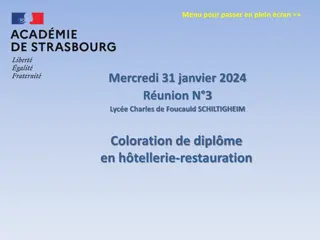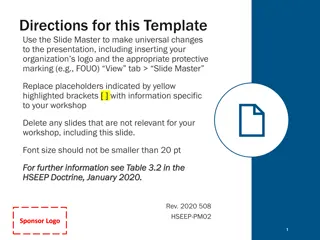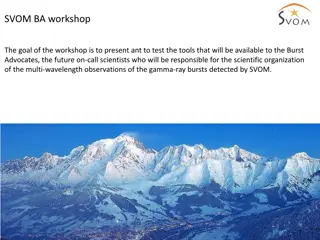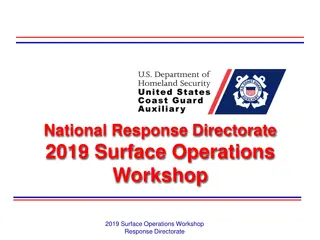FRANC3D Training Workshop: Part X Overview
Explore the agenda, file handling, analysis results, and more from the FRANC3D Training Workshop Part X held in April 2018. The workshop covers fracture mechanics analysis, FRANC3D introduction, FE model import, crack insertion, static crack analysis, SIF computation, crack growth, fatigue life approach, and file management. Learn about reading analysis results, file types, restart files, and how FRANC3D handles crack geometry, growth models, and SIF history.
Download Presentation

Please find below an Image/Link to download the presentation.
The content on the website is provided AS IS for your information and personal use only. It may not be sold, licensed, or shared on other websites without obtaining consent from the author. Download presentation by click this link. If you encounter any issues during the download, it is possible that the publisher has removed the file from their server.
E N D
Presentation Transcript
FRANC3D Training Workshop: Part X April - 2018 Drs. Paul Wash Wawrzynek, Bruce Carter, Tony Ingraffea and Omar Ibrahim Fracture Analysis Consultants, Inc.
Workshop Agenda Part I: Introduction to Fracture Mechanics Analysis Part II: Introduction to FRANC3D Part III: Finite Element (FE) Model Import Part IV: Crack Insertion Part V: Static Crack Analysis & SIF Computation Part VI: SIFs from FE Part VII: Crack Growth Part VIII: Multiple/Variable DOF Approach to Fatigue Life Part IX: SIF History & Fatigue Life Part X: FRANC3D Files, Session Log, Command Line and Python Interface Part XI: Miscellaneous 2 Part X
FRANC3D Files and Restarts Restart from FRANC3D .fdb file: From FRANC3D menu, select File - Open. Choose .fdb* file and select Accept. FRANC3D automatically reads the results file** along with the initial uncracked FE*** and the cracked FE model files *The .fdb file is a plain text file with references to other files, the flaw geometry, mesh template and crack growth parameters, and the crack growth history. **The analysis provides nodal displacement and possibly nodal temperature and crack face contact pressure results. These will be saved in the .dtp file (.pch file for NASTRAN). ***Cracks, whether initial or subsequent steps of growth, are always inserted into the original uncracked (local) FE model. 3 Part X
Reading Analysis Results Results are read automatically by FRANC3D if the results file exists. 4 Part X
FRANC3D Files 5 Part X
FRANC3D Files .fdb FRANC3D restart file stores crack geometry, growth model, SIF history, reference to other files described below .cdb/.inp/.bdf original uncracked FE model and cracked FE model files .dtp results file with displacements, temperatures, contact pressures .crk crack geometry .log GUI session log file contains FRANC3D commands .fcg fatigue crack growth data (SIF history and crack growth model) _STEP_###.* automatically named and numbered crack growth step files FE analysis code files: i.e. .db & .rst for ANSYS, .odb for ABAQUS 6 Part X
Analysis Results Read Results menu item allows a user to choose the analysis results file For ANSYS, FRANC3D reads *.dtp file (contains displacements, temperatures, contact pressure) that is created using the ANSYS macros generated by FRANC3D *.dsp file (contains nodal listing of displacements). For ABAQUS, FRANC3D reads *.dtp file (contains displacements, temperatures, contact pressure) that is created using the FRANC3D generated ABAQUS Python script *.fil file (created by ABAQUS, but has incorrect contact pressure) ABAQUS CAE report file format (use with models without *parts) For NASTRAN, FRANC3D reads *.pch file (contains displacements and temperatures) 7 Part X
FRANC3D Session Log 8 Part X
FRANC3D Session Log and Playback A session##.log file is saved for each FRANC3D GUI session. As GUI commands are executed, the command is written to the session log. An example session: OpenMeshModel( model_type=ANSYS, file_name='cube_orig.cdb', extra_files=['cube_orig.s01','cube_orig.s02'], retained_nodes_file='cube_orig_RETAINED.txt') InsertFileFlaw( file_name='test.crk', radius=0.0081) RunAnalysis( model_type=ANSYS, file_name='test.fdb', flags=[OUTPUT_MAT,OUTPUT_CS,NO_WRITE_TEMP,TRANSFER_BC,NO_CFACE_TRACT,NO_CFACE_CNTCT], connection_type=MERGE, element_series_type=SOLID_185_187, executable='ANSYS150.exe', command='"ANSYS150.exe" -b -p struct -m 4000 -db 1000 -i "test.macro" -o "test.out"', offset_mat=0, offset_csys=0, license=struct, crack_face_contact=false) ComputeSif( do_therm_terms=true, ref_temp=71.6) 9 Part X
FRANC3D Session Log and Playback The session can be played back in the GUI: from FRANC3D menu, choose File Playback Choose the session log to playback and Accept. The file can also be played back from a Command/Terminal window: > franc3d -batch ses.log 10 Part X
FRANC3D PyF3D 11 Part X
FRANC3D Python Programming Interface The FRANC3D program has a programming interface that is an extension to the Python programming language. Python is an open source, object oriented, scripting language, which is popular in engineering and scientific computing community (e.g., it is used to drive the ABAQUS GUI). The Python interface allows one to automate repetitive and possibly error prone tasks. It also provides a possible strategy for coupling FRANC3D with other computational applications. 12 Part X
A simple PyF3D Program The session log easily converted to Python. Modify this to insert many cracks: import PyF3D f3d = PyF3D.F3DApp() f3d.OpenMeshModel( model_type="ANSYS", file_name='cube_orig.cdb', extra_files='cube_orig.s01','cube_orig.s02', retained_nodes_file='cube_orig_RETAINED.txt') # lists of crack size parameters to a_sizes = [0.0160, 0.0320, 0.0480,0.0640, 0.0787, 0.2362, 0.3937] b_sizes = [0.0160, 0.0787, 0.2362, 0.3937] # loop through the crack size matrix f3d.InsertFileFlaw( file_name='test.crk', radius=0.0081) for a in a_sizes: for b in b_sizes: # create flaw, insert it, and run analysis f3d.RunAnalysis( model_type="ANSYS", file_name='test.fdb', flags=["OUTPUT_MAT","OUTPUT_CS","NO_WRITE_TEMP","TRANSFER_BC","NO_CFACE_TRACT","NO_CFACE_CNTCT"], connection_type="MERGE", element_series_type="SOLID_185_187", executable='ANSYS150.exe', command='"ANSYS150.exe" -b -p struct -m 4000 -db 1000 -i "test.macro" -o "test.out"', offset_mat=0, offset_csys=0, license="struct", crack_face_contact=False) f3d.ComputeSif( do_therm_terms=True, ref_temp=71.6) 13 Part X























